This impulsiveness that resulted in the Ungeheuer that is my Full Moon Half-Caf IPA produced something of an inundation of intense coffee flavor that drowned out the glorious hops I hoped to love in the pale ale.
Not wanting to make a similar mistake on batch 3, but still wanting to indulge my experimental instinct, I took a little bit more of a premeditated approach with the Scottish Ale.
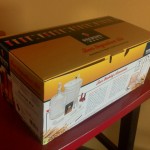 I confess I’m not quite familiar with Scottish Ale, but with the relatively low alcohol content (about 3%), I was hoping for a comparably subdued flavor that would lend itself to subtle intricacies of various adjuncts (i.e. you could still taste the extra crap I threw in there.)
I confess I’m not quite familiar with Scottish Ale, but with the relatively low alcohol content (about 3%), I was hoping for a comparably subdued flavor that would lend itself to subtle intricacies of various adjuncts (i.e. you could still taste the extra crap I threw in there.)
The Brewer’s Best Scottish Ale kit included the following: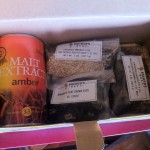
- 3.3 lbs (1.5 kg) Munton’s amber liquid malt extract
- 1 lb (454 g) LD Carlson brand Briess dried malt extract
- 4 oz (113.4 g) crushed caramel 60L malted barley*
- 4 oz (113.4 g) crushed chocolate malted barley*
- 4 oz (113.4 g) crushed smoked malted barley*
- 1 oz (28.35 g) crushed roasted malted barley*
- 1/2 oz (14.17 g) Cascade bittering hops, 6.4% alpha acid**
- 1/2 oz (14.17 g) Cascade aroma hops, 6.4% alpha acid**
- 1 packet (0.388 oz, 11 g) Lallemand Windsor dried ale yeast***
- 5 oz (141.75 g) priming corn sugar (for bottle conditioning)
- 60 bottle caps
- A single-use mesh grain bag
- 1 double-sided sheet of brewing instructions
- Miscellaneous things. Thank you Inspector #9.
*See John Palmer’s How to Brew, chapter 12.1, “Malt Types” for concise malt definitions.
**See John Palmer’s How to Brew, chapter 5.3, “Hop Types” for brief hop descriptions.
***See John Palmer’s How to Brew, chapter 6.4.1, “Dry Yeast Strains” for description.
The Adjuncts: Rosemary, Allspice, & Honey
On June 23, 2012, I brewed the usual 5-gallon batch. While the batch was boiling, I did a little taste testing with different spices. Using a cheap beer, whose name shall not be named, I prepared 3 different samples using combinations of allspice, fennel, and rosemary. I steeped different combinations of the spices in 3 glasses with an ounce or so of hot water for a couple minutes, then topped off each glass with the cheap beer, whose name shall not be named. Then I beckoned the wife to come taste test. The samples were:
- Allspice and fennel
- Allspice and rosemary
- Fennel and rosemary
The fennel gave the beer a delightful earthy anise/licorice flavor. The allspice offered a subtle warm Christmasy spice cake or almost gingerbread taste. The rosemary could scarcely be tasted, but provided a powerful piney-rosemary (duh) aroma. The wife and I decided anise flavor and alcohol can best be left to the Ouzo 12 living in our fridge, so we went with allspice and rosemary.
We had cooked up a partial boil of 2.5 gallons, to supplement that with 2.5 gallons of filtered water for the 5-gallon total. We dumped only 8/10 of the 2.5 gallons of the brew (about 256 ounces) into the plastic fermentation carboy and the other 2/10 (64 oz) split between two 64-ounce glass growlers (Revolution and Piece, in case you’re wondering). To one growler we added the allspice and rosemary. About 5 dashes of allspice and a good 3 pinches of rosemary. To the other growler we added about 1/4 cup of honey, which we had boiled in a half cup of water to kill any undesirable microorganisms.
We then added an equivalent amount of bottled water to each portion of brew (maintaining the 50/50 partial boil ratio.) We decided to use bottled water for this batch.
Water Quality
Previously we had simply used straight tap water. Papazian’s The Complete Joy of Homebrewing calls or gypsum or other minerals to control water quality or a filter to get out the chlorine. The dudes at Brew and Grow indicated that straight-up Chicago water might contribute something of a Band-Aidy flavor to your beer. A little light bulb lot up over my head when I heard this. Maybe that’s the flavor that’s been bugging me with batch #1, the American Cream Ale. It was still plenty good, but did have a hit of plastic in the aftertaste.
We bought 3 gallons of cheap drinking water and we’ll reuse the jugs to refill with filtered tap water for later batches.
Specific Gravity
I took the original gravity (OG) reading from the 4 gallons in the carboy. OG was a bit high, so I thought “To hell with that!” and added a bit more water until it fell within the acceptable range. That’s one way to ensure you always get the right OG! I brought the OG down to 1.034. I left the 2 growlers as they were, though, so they may end up with a (negligibly?) different alcohol content.
We bottled on June 30. All 3 “sub”-batches: 4 gallons of Scottish Ale, 64 oz of honey Scottish Ale, and 64 oz of allspice & rosemary Scottish Ale. The final specific gravity of the 4 gallon batch was 1.014. Doing the math, (1.034-1.014) x 131.25 = 2.6% ABV. Pretty weak, but that’s okay with me. Perhaps I should have just left the OG where it was to begin with. Oh well.
There was a perceptible honey aroma to that one and a great rosemary aroma to the latter. It was pretty exciting. We had a bit of beer left over from each growler and the carboy. Not enough to fill their own bottles, so we mixed all three together in one bottle, which we dubbed “Ultra Basturd” (sic). There was a little math involved — saving about 50 ml of priming sugar water solution for each growler.
Verdict
Cracked open our first bottle of the plain Scottish Ale about 9 days later (I think). Tasted pretty good. Deep amber color, not particularly clear, heavy carbonation. Fairly light mouthfeel. An earthy, amber, nutty-brown ale flavor. A bit too much of a sweet aftertaste. Probably not a kind of beer I’d regularly drink, but a great learning achievement.
We finally cracked the honey ale and rosemary & allspice ale on Sunday, July 22 (3 weeks after bottling). I’m currently enjoying it on my balcony as the day cools into night. For the rosemary & allspice my initial words were “That’s awesome!” High carbonation, per usual. Wonderful Christmasy rosemary aroma. Deep amber color. Lasting rosemary and allspice taste with a bit of a molasses finish. I think it would go very well with gingerbread.
The rosemary nicely combats the sweetness of the plain Scottish Ale, while the allspice takes away the (in my opinion) slightly less desirable ale bitterness. Don’t get me wrong. I’m quite the hop head, but I’m not a huge English (or Scottish, as the case may be) ale fan. I’m more of a pale ale fan.
The honey ale is excellent too. Not particularly heady at all, although equally carbonated. The bottle also had considerably more sediment than the plain and the rosemary allspice. It’s a fairly opaque amber beer. The honey aroma is minor but perceptible. The initial taste is rather similar to the Scottish ale, but it definitely has a different sweetness for the aftertaste. You can also notice the “coffee” flavor of the Scottish ale, whereas I think the rosemary allspice somewhat kicked that out.
Between the three — plain Scottish ale, rosemary allspice, and honey — I’d certainly grab another rosemary allspice before the other two, and I think I’ll keep that savory combo in mind for other concoctions.
Cheer!

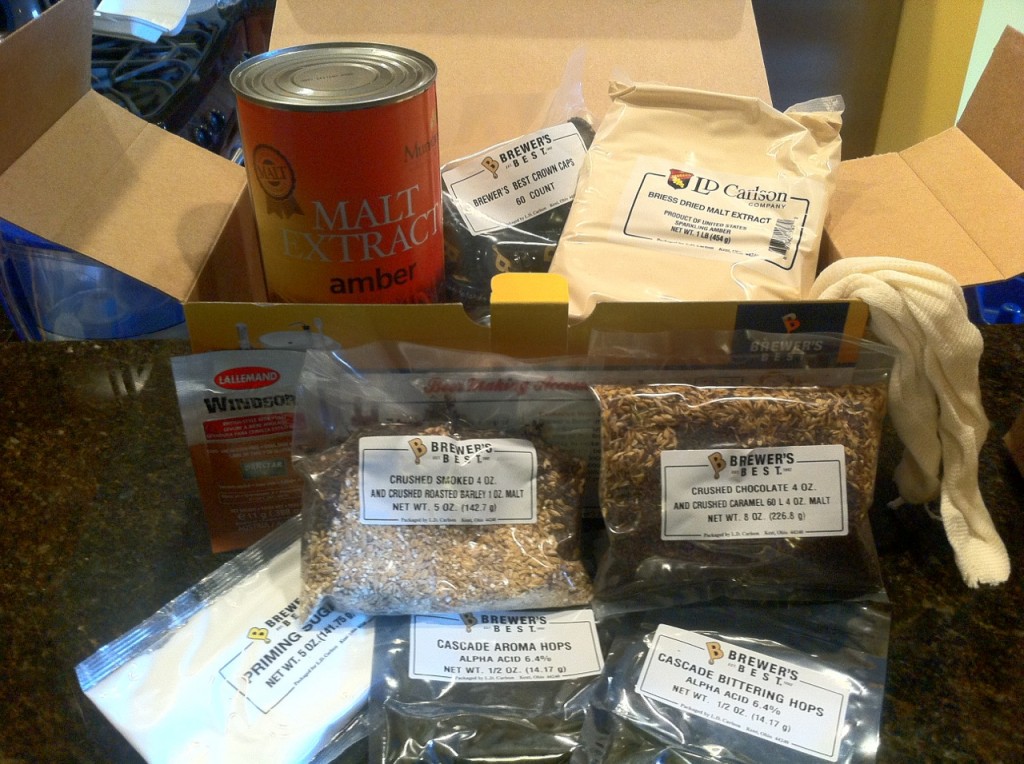
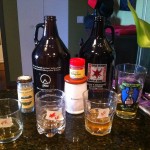
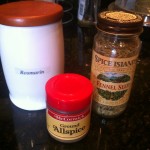
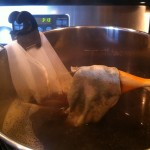
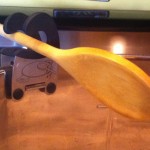
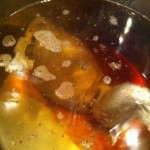
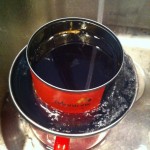
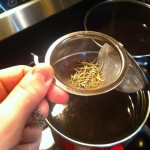
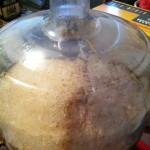
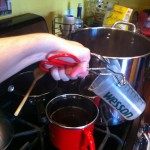
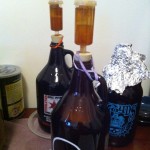

I just this last Sunday brewed and was curious about how it fermented for you. For me, I had a nice layer of krausen forming almost immediately and the next day it was sitting at 70F and still had a nice layer of krausen. However, on the third day the krausen dropped and the temp dropped to 66F. I’ve got it in a regulated chest freezer with another carboy that has been at a steady 68F so there has been no fluctuation in temperature change. All activity in the air lock has stopped on the fourth day. Did you experience similar results?
Hi AJ. Thanks for reading and commenting! Sorry for the tardy reply. I think you’re a better note-keeper than I am. Within the first 24 hours, I had a healthy krausen, which crept most of the way up the remaining space in the carboy, but didn’t quite reach the airlock. According to my photographic evidence, the krausen had receded to a mere inch or so about 28 hours into fermenting and continued to drop from there. I don’t specifically recall the temperature, but my brews tend to be around 72-74F for the whole duration (it’s a battle between the beer and keeping the wife and hairless cats at a comfortable temperature.) Sounds like you’ve got a pretty fancy setup. Have you posted any photos anywhere?